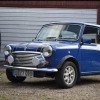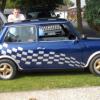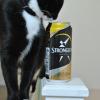A-Cell, the ORIGINAL design was very well proved, round and round the Chalgrove aerodrome perimeter, after the subfremes were introduced to deal with the fatigue cracking experienced in the subframe-less orange box prototypes.However, I do not believe that the rubber mount design was ever "properly" tested, because I had two Minis, one from new, with that abominable arrangement, and within 10k miles of very normal use, mainly motorway cruising, they both broke one or both mounts. Replacements did not last long either, and there is a serious design error because the toeboard mounts, which structurally are important, are not safety through-bolted. In short, I think that a complete idiot designed that arrangement, which is just about as bad as bad can be. I was forever changing mounts, until I twigged that they were also the cause of bad handling, and made my own solid mounts, before such things were commercially available.
I suspect that it was the well-known problem of having to test to some standard or other, however the test did not bear much resemblance to real life usage. A bit like the combined cycle MPG test on modern cars, which is never, ever approached by disappointed owners in normal driving, because it is purely a government-dictated standard test with no relation to reality. BMW on certain models tested their structure to some standard, probably TUV, and the rear suspension mounts turned out to have serious fatigue problems, again because the test cycle bore no relation to reality. I strongly suspect that the testing applied to the squidgy-subframed Mini similarly bore no relation to actual usage. Crashworthiness will have improved, because the mount will fail in a severe frontal impact, allowing the subframe leg to deflect down and back under the floor, where the solid design used to make the floor crumple, trapping the drivers feet. (Seen umpteen crash test dummies trapped in Minis at TRRL.)
I have looked at a few Minis belonging to other people, and in most cases I found that one or both toeboard mounts were broken, and in many of these cases the dreaded inner wing cracking had started. That problem was never seen on Issigonis' design.



















